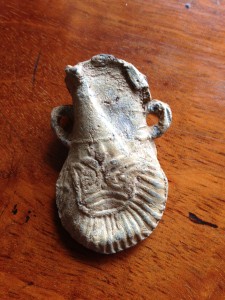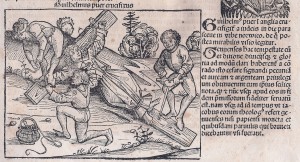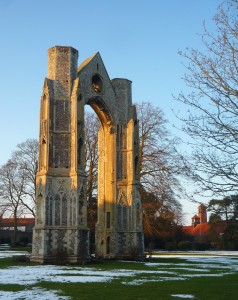In February 2012 we visited Walsingham in Norfolk. It was a gloriously cold and crisp day, with recent snow still lying upon the ground; the winter sun illuminating the silver-edged ruins of the abbey. In the icy chill of that day it was hard to conjure the image of early pilgrims to this place, barefoot and penitent, but filled with joyous apprehension nonetheless. Many walked the last mile (for walk they did from however far away) without shoes as a visible act of atonement, stopping to shed them at the 14th century Slipper Chapel nearby.
When Henry VIII made pilgrimage to this place in the early 16th century, according to Sir Henry Spelman, he reputedly walked barefoot from Barsham to the chapel of Our Lady, and offered a necklace of great value. Sad it was then, that he should be the final instrument of the shrine’s ruination in 1538, the image of Our Lady of Walsingham ultimately being carried away and burned at Chelsea.
Later that day, in a tiny antique shop in the village, I found a deeply evocative memento of those early days of pilgrimage. The Curiosity Shop is a delightful place, run by the engaging and welcoming Fr. Paul Kinsey. This is no ordinary antiques and bric-a-brac shop, but a place of compelling stories, sincere welcome, and beguiling goods. One wall of the shop is adorned with a magnificent 16th century wall painting, deeply symbolic of Walsingham’s suffering, and in particular the village’s reaction to the brutal destruction of the shrine. It speaks eloquently, though obtusely, of the people’s deep resentment and horror.
Amongst the familiar collections of ceramics, glass and silver to be found here are rare items of religious interest – “rosaries, statues, pictures, medals, and rare and important Christian items”. Two items wooed my purse that day, but only one was to leave with me.
My eye was first drawn to a leaf from the Nuremberg Chronicle. Printed in 1493, the Liber Chronicarum as it was also known was a compendium of history, geography and natural wonders. Published in a large folio of just over 300 leaves, it contains 1,809 illustrations from 645 woodcuts. Most of the cuts were executed by Michel Wohlgemuth and Wilhelm Pleydenwurff. Albrecht Dürer was one of Wohlgemuth’s apprentices from 1486-1489, and may have participated in the designing of some of the illustrations for the craftsmen who cut the blocks. Dürer subsequently painted Wohlgemuth’s portrait in 1516.
The leaf enticed me, but I moved on.
 Then in a small glass cabinet I saw an object of beguiling beauty, deeply resonant of this ancient and spiritual place. The small lead ampulla or pilgrim flask, dating from around the 14th to early 16th century, seduced me in a wholly irresistible way. One face was decorated with a large crown within scallop-like radiating ribs, the reverse bore the remains of the rounded base of a lily pot, the lily pot being an emblem of Our Lady and therefore possibly referring to the Holy House of Our Lady at Walsingham. As I held it in my hand I felt the connection, timeless and vital, to the hand that first held it, to the place of its first purchase, not least to the hand that let it fall. There was no doubt in my mind; this diminutive treasure was now mine.
Then in a small glass cabinet I saw an object of beguiling beauty, deeply resonant of this ancient and spiritual place. The small lead ampulla or pilgrim flask, dating from around the 14th to early 16th century, seduced me in a wholly irresistible way. One face was decorated with a large crown within scallop-like radiating ribs, the reverse bore the remains of the rounded base of a lily pot, the lily pot being an emblem of Our Lady and therefore possibly referring to the Holy House of Our Lady at Walsingham. As I held it in my hand I felt the connection, timeless and vital, to the hand that first held it, to the place of its first purchase, not least to the hand that let it fall. There was no doubt in my mind; this diminutive treasure was now mine.
With hearty thanks, and a sincere wish that we would call again one day, we left Fr. Kinsey and made to the pub for lunch, then back into the grounds of the Abbey to say our farewells. As we drove back towards Norwich that afternoon I luxuriated in the indulgent knowledge of possession, as the ampulla nestled safely in my pocket; and all the while mourned the loss of the Nuremberg leaf.
That summer my eldest daughter graduated MA, and as a token of thanks for our support during her years of study she bought my wife and I gifts. As my turn came to tear the paper I had no idea what the curiously large but slim package could be. I removed the wrapping and separated the protective cardboard covers. There lay the Nuremberg leaf.
 I am looking at that leaf now, as I write, and my eye is drawn to a single word, Norwico. This word, the Latin variant of Norwich, could quite possibly be the first printed reference to that city. And so it completes the link; the link between the places of my daughter’s study, the county of the Holy pilgrimage, the disinterment of the ampulla, and the long road of imagination from Walsingham to Nuremberg.
I am looking at that leaf now, as I write, and my eye is drawn to a single word, Norwico. This word, the Latin variant of Norwich, could quite possibly be the first printed reference to that city. And so it completes the link; the link between the places of my daughter’s study, the county of the Holy pilgrimage, the disinterment of the ampulla, and the long road of imagination from Walsingham to Nuremberg.

